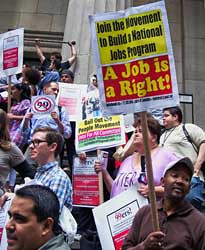
Demonstration in New York protest the lack of benefits for the longterm unemployed in the United States.The filing for unemployment benefits rose to 500,000 in one week during early August 2010., a photo by Pan-African News Wire File Photos on Flickr.
U.S. economy hardly moved in 2nd quarter
August 30, 2012
By Martin Crutsinger
Associated Press
WASHINGTON -- The U.S. economy grew at a tepid 1.7% annual rate in the April-June quarter, suggesting growth will stay weak in the second half of the year.
Slightly stronger consumer spending and greater exports were the main reasons the Commerce Department reported Wednesday that growth was better than its initial estimate of 1.5%. Still, growth has slowed from the 2% annual rate in the January-March quarter and the 4.1% rate in the fourth quarter of 2011.
Economists say they expect only modest improvement in the second half of the year. Most say the economy will keep growing, but at a subpar rate of around 2%.
"The economy was sluggish in the second quarter and the slight upward revision ... does nothing to change that picture," said John Ryding, an economist at RDQ Economics, in a note to clients.
The report was the government's second look at gross domestic product for the second quarter. GDP measures the country's total output of goods and services, from the purchase of restaurant meals to construction of highways and bridges. A third and final estimate of second-quarter growth will be released next month.
Growth at or below 2% is not enough to lower the unemployment rate, which was 8.3% in July. Most expect the unemployment rate to stay above 8% for the rest of this year.
A weak economy and high unemployment could hurt President Barack Obama's re-election chances and bolster Mitt Romney's campaign. Republicans are in Tampa this week to formally nominate Romney and have pointed to the dismal growth in making the case to elect their candidate.
Economist Robert Brusca said the various changes in the second estimate should be positive for growth going forward. He noted more consumer demand in the spring than previously thought, which drives 70% of economic growth. And he pointed to less restocking of shelves, which suggests businesses could replenish their stockpiles in the current quarter. Faster inventory growth increases factory production, which boosts growth.
But Paul Dales, senior U.S. economist at Capital Economics, said the small revision to second-quarter growth "offers little comfort."
"We are already two months through the third quarter and more up-to-date figures show that the economy is still struggling," Dales said.
Slow growth could prompt the Federal Reserve to take greater steps to boost the economy when policymakers meet again Sept. 12-13. In late July, Fed policymakers spoke with increased urgency about the need to provide more help for a weak U.S. economy.
Chairman Ben Bernanke could offer some clues Friday to what the Fed might announce when he speaks at a Fed conference in Jackson Hole, Wyo.
Some suspect the Fed will wait to see how the economy performed in August, especially after July's data was better than expected.
Employers created 163,000 jobs in July, the most since February. Consumers stepped up retail spending, factories produced more goods and the housing recovery continued with increases in both new and previously occupied homes.
The upward revision to second-quarter growth was largely because consumers spent at a slightly faster pace than first estimated. Consumer spending grew at a 1.7% rate, better than the 1.5% initially estimated.
No comments:
Post a Comment